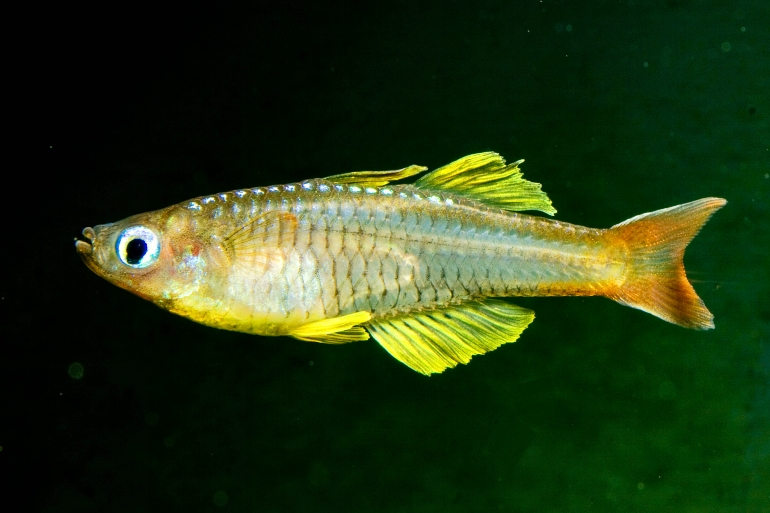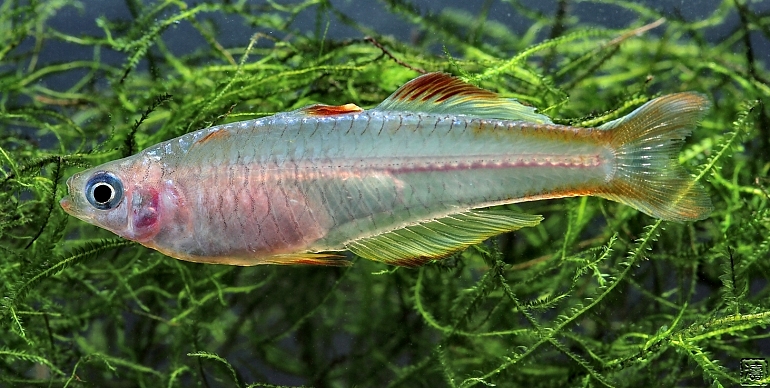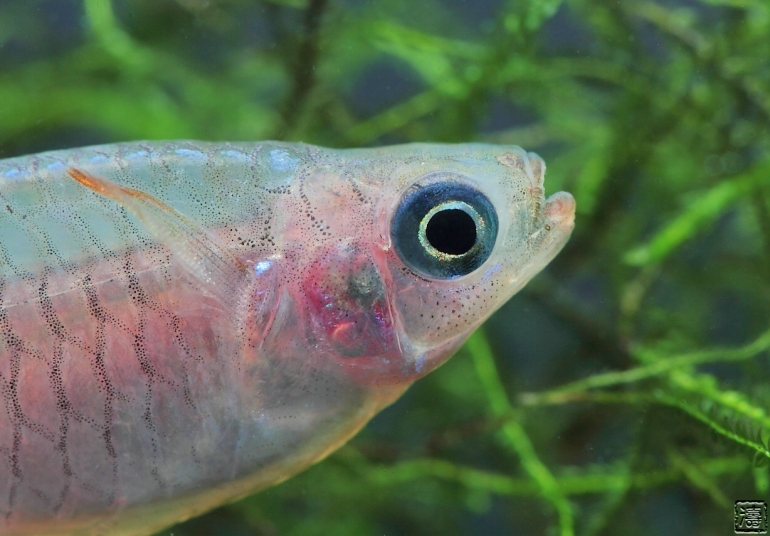|
 |
Pseudomugil ivantsoffi [Kopi River] - photo© Gary Lange |
Allen and Renyaan, 1999
Ivantsoff Blue-eye
Species Summary
The head and body of male Pseudomugil ivantsoffi is semitransparent, often with a bluish or reddish hue. Iris of eye intensely blue. The opercle, abdomen and swim bladder region are silvery. The upper half of first dorsal and anterior half of second dorsal fins, and edge of anal fin are bright red. The dorsal and ventral contour posterior to second dorsal and anal fins edged with similar red; the upper and lower third of caudal fin also red. The pelvic fins are pinkish. The edges of some scales on abdomen with narrow black margins. Females overall semitransparent, lacking bright red shades of male; opercle, abdomen and swim bladder region silvery; some scales on anterior half of body with faint, fine black margins; fins mainly translucent to faintly yellowish, the outer tips of the first and second dorsal fins yellow. This is a small species, slender and laterally compressed, growing to a length of around 3-4 cm SL. Named "ivantsoffi" in honour of Walter Ivantsoff, of Macquarie University, Sydney, Australia, in recognition of his valuable contributions to the knowledge of atherinoid taxonomy.
This fish was initially identified as Pseudomugil reticulatus, based on the close resemblance of females from the Timika area to the single known example of that species collected about two kilometres east of Ayamaru (Ajamaru) Lake in the centre of the Vogelkop Peninsula. However, recent collections near the type locality of Pseudomugil reticulatus, which lies some 900 km northwest of Timika, revealed that the two populations are distinctive.
 |
Pseudomugil ivantsoffi [Deky Creek] - photo© Taoyeah Deng |
Distribution & Habitat
Pseudomugil ivantsoffi have been found in the tributaries of the Ajkwa, Iwaka, Wataikwa and Kopi Rivers in the Timika-Tembagapura region of West Papua. When first collected in 1995 this species was common in several creeks. The habitat consisted of small (1-2 m wide), shallow, slow-flowing streams in dense rainforest. The water was generally clear, but some were tannin-stained, with sparse aquatic vegetation. Bottom conditions included sand, gravel, cobble, and rocks. Water temperature and pH values ranged from 24-28°C and pH 6.7-7.8 respectively. Other fishes collected from these habitats include Pseudomugil pellucidus, Pseudomugil novaeguineae, Melanotaenia goldiei, Melanotaenia rubrostriata, and Melanotaenia ogilbyi.
The same species and habitat conditions were encountered in January 1997, but by the following year, after a prolonged El Niño related drought, the two species of Pseudomugil, as well as Melanotaenia ogilbyi, could not be found in any of the former areas. The Kuala Kencana housing development and recent forest destruction near the Kopi River sites may well have caused the local extinction of these species. However, they no doubt will continue to survive in primary forest to the immediate east and west of the Timika region.
The Timika region includes the following rivers: Kamora River (Kamora, Tuaba, Wataikwa, Iwaka) Wania River, Tipuka River, Ajkwa River, Minajerwi River (Minajerwi, Kopi, Aimua) Mawati River, Otokwa River, Mamoa River (Mamoa, Seruka) Atuka River (Atuka, Wapuka) [The Atuka River meanders north to its junction with the Kamora River, very close to the village of Mioko.]
The dark colouration in 'blackwater' streams is due to the presence of organic substances. This black or tea colouration is quite common in the area, due to extensive heath forest. These streams start in the heath and are shorter and narrower than the rivers which begin in the mountains and have enough volume from rainfall to dissolve the colouration. The blackwater streams all drain into the rivers.
 |
Pseudomugil ivantsoffi [Deky Creek] - photo© Taoyeah Deng |
Remarks
In 2004, Iain Wilson and Charles Nishihira collected live specimens of this species from the Iwaka River (Deky Creek), which is a tributary of the Kamora River and the Kopi River, which is a tributary of the Minajerwi (Muamiua) River, along with specimens of Pseudomugil novaeguineae, Pseudomugil pellucidus, Melanotaenia goldiei and Melanotaenia rubrostriata. Additional live specimens have been collected from the Kopi and Wataikwa Rivers in the vicinity of Timika. Live specimens have also been collected Heiko Bleher. Two main varieties (Deky Creek and Kopi River) are currently available in the aquarium hobby.
Literature
Allen G.R. & S.J. Renyaan (1999) Pseudomugil ivantsoffi (Pseudomugilidae), a new species of blue-eye from the Timika region, Irian Jaya. Aqua, Journal of Ichthyology and Aquatic Biology 3(4): 163-168.
Allen G.R., K. Hortle and S. Renyaan (2000). Freshwater Fishes of the Timika Region, New Guinea. P.T. Freeport Indonesia, Timika, Indonesia.
Ivantsoff W., Aarn, M.A. Shepherd and G.R. Allen (1997) Pseudomugil reticulatus (Pisces: Pseudomugilidae), a review of the species described from a single specimen from Vogelkop Peninsula, Irian Jaya, with further evaluation of the systematics of Atherinoidea. Aqua Journal of Ichthyology and Aquatic Biology, 2(4):53-64.
Muller K (2004) Biodiversity of New Guinea [unpublished document]
Adrian R. Tappin
Updated June, 2016



|
|

